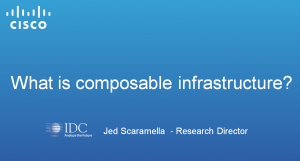































"Did you say compostable infrastructure? That means using a biodegradable cardboard chassis that can go in the compost bin, right?" This conversation is more common than you think right now as people are introduced to this for the first time. So what exactly doescomposableinfrastructure mean? Perhaps the best description I've heard comes from James Leach who recently told me "our customers need us to wrap code around the server, not sheet metal." I think that concept gets at it pretty well, and no surprise since he's one of the people behind our M-Series Modular Servers and Cisco System Link technology. Still, it's early days for this concept in the industry and many customers we talk to haven't been exposed to the term.
We took some time recently to interview Jed Scaramella from IDC to help explain it all. Here's another segment in that series, this one focused on answering the question, "What is Composable Infrastructure?"
Composable infrastructure is is emerging out of two trends: disaggregated servers and software-defined infrastructure. Both are prerequisite capabilities: you need be able to take humpty dumpty apart AND put him together again. Disaggregation is where we unbind local shared storage and network I/O from the processor and memory. Subsystems are no longer bound by the server chassis or the traditional motherboard. Then, with a unified control plane and API, these physical and logical resources are pooled and management software composes the resources on demand, so the system can be created to conform to the unique requirements of the workload. That's the software-defined part.
Path to "Infrastructure as Code"
While many are just beginning to talk about composable infrastructure as a future strategy ("Houston, we have a vision...") Cisco has been executing on disaggregated systems and software defined infrastructure since the introduction of UCS, through three key areas of innovation:
UCS M-Series has taken this a step further by disaggregating local storage and the CPU/memory complex through the use of the Cisco System Link Technology.
But taking all the pieces apart isn't what's important. It's putting it all back together again into a system to run applications. For that we employ the proven UCS Manager Service Profile model to define combinations of shared local disk and I/O across multiple compute/memory complexes and create servers out of subsystems in a software defined way. This makes it easy to conform the physical infrastructure to the workload instead of doing it the other way around, say, with a hypervisor. This is composable infrastructure at the foundational level. I'll mention as an aside that this also breaks the cycle of replacing entire servers for the purpose of a processor refresh. Just replace the processor & memory, leave everything else in place. This is a significant benefit in its own right and the subject of another post. For more on M-Series and System Link go here.
I'll point out again that other technology vendors will continue to lack true server disaggregation and composable infrastructure for some time, but won't hesitate to talk about it as a strategy or wash products with the buzzword. Cisco customers are already there with UCS.
Revolution by Evolution: Balancing innovation with investment protection
Composable infrastructure offers up new possibilities in terms of automation and efficiency, but you shouldn't have to abandon your present operational model to implement it. Cisco offers software defined, composable infrastructure today, using our proven UCS control plane, management and API
Along the way we've established a strong partner ecosystem through the open API in UCS management. This ecosystem supports a broad range of tools that cover the entire service management lifecycle, from service orchestration, through deployment and configuration, as well as monitoring and analysis. This ecosystem lets you preserve your existing investments in infrastructure and management tools while evolving your procedures to expand automation to deeper granularity and higher efficiency.
Composable infrastructure allows you to do work faster in a consistent and predictable way. The combination of model-driven automation plus best practices defined in Service Profiles makes sure routine tasks are implemented consistently and correctly to reduce risk. The broad, mature ecosystem around UCS management also reduces risks by allowing you to use your existing management tools and processes as you incorporate new technologies, like composable infrastructure, into your environment.
Coming Next: Let's talk more about infrastructure as code.
If this sounds like fertile ground for a conversation around DevOps and continuous development/innovation, you're right. More to come on that in this blog series.
-Todd
 Hot Tags :
UCS
devops
servers
UCS m-series
Composable Infrastructure
Hot Tags :
UCS
devops
servers
UCS m-series
Composable Infrastructure